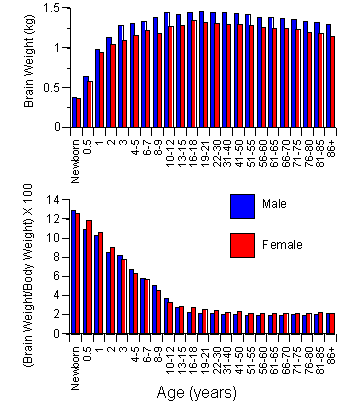Her brain, his brain
A woman's brain weighs approximately 12% less than a man's brain. Until some decades ago, this was taken by many people as the biological correlation of a presumed intellectual superiority of human males compared to females. This difference, however, only reflects the larger body size of males, compared to females, in the human species. If the brain weight is measured not in an absolute terms but in relation to body weight, the difference disappears and, actually, a small difference favoring females tends to emerge.
 |
Fig. 1: Age-related changes of brain weight in males and females expressed in absolute terms (upper graph) or relative to body size (lower graph). Data from Dekaban & Sadowsky (Annals of Neurology, 4, 345-356, 1978). |
Today, we know that some small,
but significant, differences actually exist between a woman's and a man's brain. In
particular, the connections between the two cerebral hemispheres are relatively
more developed in the woman, compared to the man, while in discrete brain centers of the
brain region called
hypothalamus![]() , the man possesses larger and more
numerous neurons. On the other hand, using appropriate tests it is possible to show that some intellectual activities are
performed differently by women and men.
This is the case, for instance, with logical and mathematical thinking,
linguistic and computational ability and spatial orientation. In general terms, it
is possible to hypothesize that a man's thinking works through logical schemes based
on a rational approach, while a woman is more able to use an intuitive approach in
her reasoning or, in other words, that brain circuits are more rigid in men and
more plastic in women.
, the man possesses larger and more
numerous neurons. On the other hand, using appropriate tests it is possible to show that some intellectual activities are
performed differently by women and men.
This is the case, for instance, with logical and mathematical thinking,
linguistic and computational ability and spatial orientation. In general terms, it
is possible to hypothesize that a man's thinking works through logical schemes based
on a rational approach, while a woman is more able to use an intuitive approach in
her reasoning or, in other words, that brain circuits are more rigid in men and
more plastic in women.